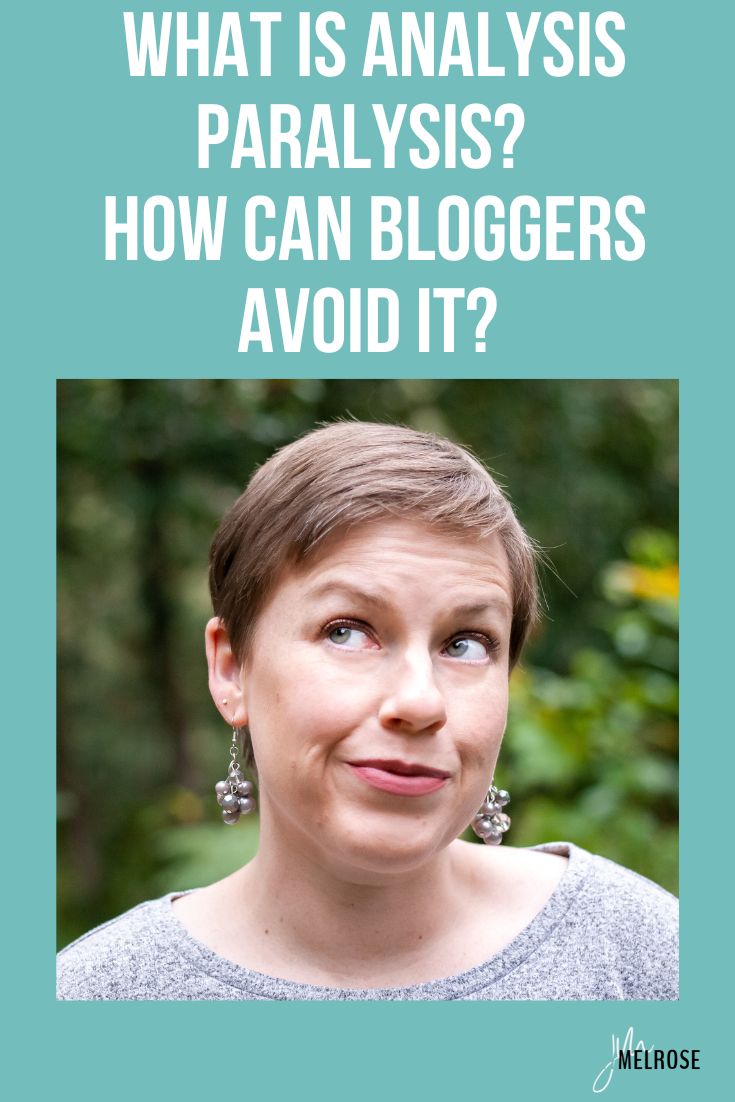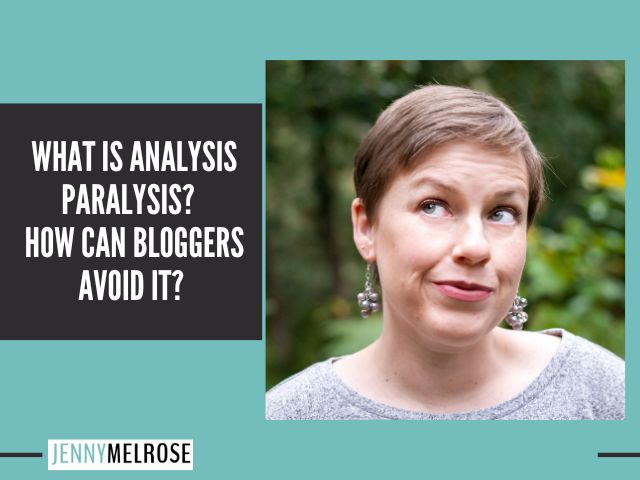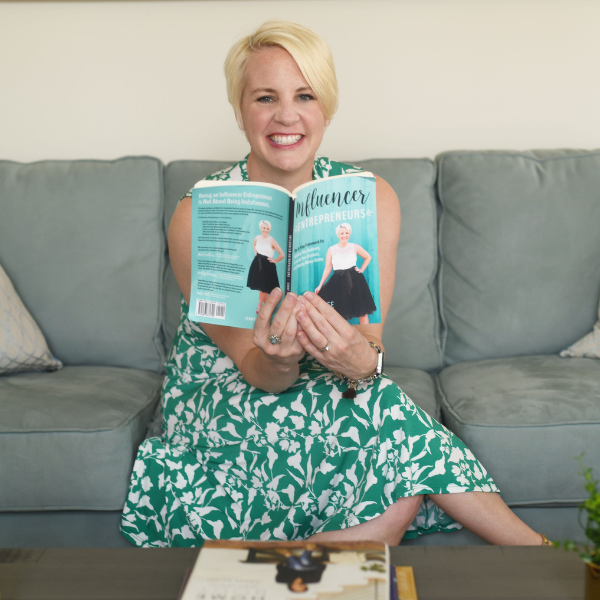One of the most difficult thing to overcome as a blogger is analysis paralysis, but what is analysis paralysis and how can you avoid it?
IE 331: What is Analysis Paralysis & How Bloggers Can Avoid it with Liz Stapleton

Today’s guest, Liz Stapleton, is a lawyer and a blogger.
She is the founder of multiple blogging websites, including Less Debt, More Wine (a personal finance website), ElizabethStapleton.com (helping people understand the legal side of blogging), and Blogger Breakthrough Summit (a free virtual summit designed to help bloggers with both their time and goals).
Liz has been blogging since 2014 and loves to make bloggers’ lives easier with action-oriented content and training to save their sanity and help them earn more.
We’re diving into analysis paralysis and how bloggers can avoid it.
How do you define analysis paralysis?
Analysis paralysis is when you are so overwhelmed with either information or a to-do list that you refuse to do any of it and revert back to busy work that you know.
What is an example of analysis paralysis?
That could be tweaking your website because it’s not perfect or creating more graphics.
What it really boils down to is fear of stepping outside your comfort zone to get those new things going.
You resort to things that won’t move the needle at all.
What would you say is the number one incident that causes analysis paralysis for bloggers?
I’d say information overload.
Especially when you start out, you’re drinking from a fire hose.
There are so many great tools and resources.
For example, my summit is awesome, but includes 50 speakers.
Don’t try to attend everything. It’s too much.
It takes me months to process all of this stuff, Pick a track and stick to it; whether you’re beginner, intermediate, or advanced. There are also all these great bundles out there. It’s the same idea. It’s so much fantastic content.. But you need to really pick one thing to focus on and implementing before you dive into other stuff.
Everyone likes shiny objects. Learning is fun. It’s not nearly as hard as taking action.
Some of us, especially those who consider themselves type A, have a tendency to be eternal learners.
We love all the information.
We want to listen to all the people and do it all. Sometimes, it is really hard to wade through the noise to figure out what steps we need to take.
How can we actually determine those steps in business we need to take?
There are a couple different ways you can go about it.
First of all, especially if you’re type A, make your list, go through it, and pick something.
I’d go with either something that you know for sure is gonna move the needle or, if you’re not sure what’s gonna work best, go with what scares you most.
Determine to work on this for just 15 minutes and consider that a win.
A lot of times you get sucked in and work longer than 15 minutes but it gets you going.
You don’t need to get everything done that day. It doesn’t need to be perfect.
I am a big encourager of taking imperfect action and “done is better than perfect.”
Very few things can’t be changed or updated later.
That’s really one of the best ways to go about it. Pick one thing and give it time to work.
Don’t try another strategy related to that until you’ve given it time to work.
Go work on something else but give stuff time to work.
That’s where the shiny object syndrome comes from.
We do something and we think it should be instant results.
That’s not true, especially in blogging. You might have some little quick wins, but in reality, stuff takes time.
If there’s stuff you need to do to keep going while you see if it’s going to work, have that on your to-do list and make it something easy to knock out.
If you want to start something new, make it something unrelated, a completely different path, because you’re not going to know what worked if you’re doing multiple strategies at once.
What is a significant amount of time for testing strategies?
I see a blogger saying “I tried it for three days, it didn’t work. Or, it doesn’t fit my audience. What would you recommend?
It depends on what you’re doing.
If you’re doing SEO, three to six months. I
f you’re running ads, it will depend on your budget, but probably at least a couple of weeks to really get enough traction and interaction to see what’s working.
Hopefully, your research has told you how long you need to give it to work.
SEO could even be six to nine months, depending upon the niche and how you are keeping track of everything.
When it comes to the email marketing side of things, that’s an area I notice bloggers will kind of flip around the most.
For example, “I tested emailing my list once a week and I did it for a week and it didn’t work.”
That math means you sent one email. That’s really not testing it.
It is the same thing with our social media strategies as far as Instagram or Pinterest or whatever else it can be.
I like to tell people to look at things for six weeks. Really test it and be consistent.
If you’re not being consistent, you’re not really working with the right amount of data.
If I was back in research days in college, I’d be told to start over. That’s important to really think about.
You have to be consistently putting that out there in order for it to work.
You hit on another thing. You need a big enough data pool.
Newer bloggers might take longer to test something and to get that much data than more established bloggers.
If you need a hundred page views to a post to see if it’s converting, a brand new blogger might take six months.
A really established blogger could take two days or less. Don’t try to be like the blogger that managed to figure it out in two days.
They might have a completely different amount of data to work with than you do.
It goes to that idea of not comparing your middle to someone’s end, someone’s beginning, or whatever that looks like for them.
Whether you’ve been blogging for 10 years and you’ve never tried a product, or you’ve been blogging for a year and you’ve tried a product, your list size can be very different.
The way you have maintained it, engaged with them, nurtured them through moving forward, and determining whether it’s gonna be a successful product launch or not, can be very different.
For a lot of us that are creatives, we hate the numbers but the numbers are so important.
It is such a huge piece of being able to determine if you move on to the next strategy and the next best thing that I’m going to do.
How do we get unstuck from analysis paralysis?
Let’s talk about how we get unstuck from analysis paralysis. We’re in it and we keep going back to the same thing so we know that we’re just knocking it off of our to-do list. How do we get past that and actually move the needle?
You’ve got to really look at planning.
Take a step back to look at your bigger picture and what your goals are.
Then, see what is on my to-do list that’s actually moving towards those goals and get rid of what isn’t.
I always try to do this every couple of months especially.
I am stepping back and looking at tasks.
A task may not take a lot of time. I do it every week, but it’s not actually producing a lot of results.
I could probably let that go and someday when I’m tired and don’t have energy for other things, I can go do that a little bit.
It will help some, but it’s not a huge needle mover.
Take the time to take the step back.
I think so often we get caught up in the nitty gritty details and working in our business that we don’t step back to work on our business. It’s amazing the insights you will get from your blog and what you’re doing when you take a step back.
Maybe sit down with a friend and have them ask you, “What is it you do?”
Just trying to explain that can help really clarify a lot of things.
To a lot of people who aren’t in this, this is like a foreign language.
I’ve been doing it eight years and most of my family still doesn’t quite know what I do. Trying to kind of explain it to someone will help provide you with some clarity if stepping back is something you struggle with.
A huge piece that we often forget is positioning.
Being able to stay who you help and what problem you solve for them is a huge piece of this.
A lot of times, when we started, we were just throwing spaghetti against the wall. We were just trying to see what was going to work, trying to be creative, and just do the things. You’ll build it. They’ll come.
You have to be poignant in what you are writing.
It’s really important, especially for SEO purposes, that you know the problem that you serve and what you are trying to be an expert in when you are speaking to your audience.
Whether you see yourself as that expert or not, Google needs to see you as that expert if you are determining that you wanna solve that problem for your audience.
How can we avoid analysis paralysis?
Planning. If you have a regular like planning day in your list of things to do, that helps.
You need a tool to use. I use click up. I have recurring tasks.
One of those is taking a step back.
I have recurring tasks like a CEO day, check your bookkeeping, look at your big picture, things like that. Having a plan where you’re checking your data metrics that matter to you.
That’s a really boring word, but numbers matter to you; revenue page views, email open rates, conversion rates, whatever numbers that matter for your goals.
Not just vanity metrics but ones that tie to your goals or key metrics. I am making notes of the conversion rates. If I want to reach this many sales, this is how many views I need on that.
How can I get that number of views?
Planning my action items around that –I need to try to get more podcasts or I need to guest post more. I need to really rev up my affiliate program.
There’s a lot of different ways I could do. When you know what goals you’re trying to get towards, it’s a lot easier to zero in.
For newer bloggers, it’s harder because you don’t have the data to really know what you should be focused on, so you’re trying a lot of different things.
Stick with trying to get really, really good at one thing and before you try to take on something else.
Make sure you’re constantly stepping back on that one thing and asking “Am I getting better? Is this working? How can I tell? What can I do differently?” Step back and brainstorm.
There are so many things that we do because we’re supposed to.
We’re supposed to have an email list.
We’re supposed to email our list. But if you take a step back, you might find your kind of unique perspective.
You’ll come up with a twist on something that you don’t really see a lot.
That’s kind of exciting for you and for your audience because it’s not the same old thing over and over again. It may not always work out, but you’ve got to try it at least once. I would say more than once.
I’ve been doing this for eight years. I still learn.
I go to my own summits and paid trainings and all that stuff.
One thing that really stuck with me, from 2022, was that you need to run something at least three times to know if it’s gonna work or not.
I haven’t been doing that.
That is a great piece of advice.
You won’t know if it’s working from trying it one time. “I emailed my list once a week, one time. You got to try it a few times because you are going to get better, your backend is going to get better, your organization is going to get better, and you’ll be able to streamline and see if it’s really going to work.
I love the way that you talk about that it has to start with the goal.
A lot of times when people come into my mastermind programs, they’ll tell me “I want to increase my revenue to 5K consistently by the end of the six month period.” Then, they look at me and say “okay, how do I do that?” The questions to ask are:
- What are our revenue streams?
- How are we doing this?
- What’s going to be able to help you to increase that revenue?
It comes down to looking at where you are and then trying to be able to figure out which steps you can take to improve upon.
When revenue comes into play, you need to consider a few things.
Page views are going to increase your ads. SEO is obviously number one.
Having that list is going to be important, and then looking to see how else I am monetizing.
Am I doing it through sponsorships? Am I thinking about my own product or my own service?
If I am going to launch my own product or service, I need to have a larger list.
I need to be doing strategies that are going to help me grow my list like bundles.
I’m going to do a summit, I’m going to do a list swap.
I‘m going to do these things that are going to move the needle on the number of subscribers that I have on my list.
That’s the piece where a lot of people get stuck. They don’t know. They can look long-term at the goal, but don’t know what steps to take next. Where do I go?
Do you ever find foundational things that bloggers are missing that need fixed before they can move forward?
The legal stuff.
People don’t even think about it.
I have background as a lawyer.
I do have another site with legal templates for bloggers.
You need to go through and make sure that you have the right policies in place, but also that you’re properly displaying whatever disclosures or disclaimers you need to.
The biggest mistake is that people will set it up on their site so it shows on every page. Great.
Where are you putting it in your email? They don’t even add it in email or it’s in the wrong place.
If you’re an advanced blogger, you can hire a lawyer.
That is always going to be the best option but a lot of people can’t afford that .
If you’re not in that boat, look for templates from lawyers who are also bloggers who understand the various things that you are doing.
A regular lawyer that you go to for buying a house, creating a will, etc. are totally different from the online world.
There are a lot of great lawyers and law firms that focus on serving the online community.
Beyond that, they’re questioning, “Why isn’t my list growing?” because that’s a key thing.
Your website should be converting generally 2% of your audience to your list.
That is a good conversion rate. If you are like 0.1%, something is wrong.
- How many and where are your opt-ins?
- Are they visible?
- Are they eye-catching?
- Do you only have it in your footer and nowhere else on your site?
- Are people getting all the way down to the footer?
There are things that can be easily fixed and make a big difference in the long term.
The two biggest things are the legal stuff that people are just completely ignoring or they are using free templates that aren’t really covering them.
Go look at your website in an incognito window, play around and see what you find.
Your back-end and the vision in your head of what your website looks like could be totally different from what the users really experience.
I love the fact that you brought up the location of your opt-in because that is something that a lot of people will struggle with.
I have a lot of bloggers that come to me that have 300,000 page views, but they have no opt-in.
They have a newsletter and think people will just sign up for the newsletter and it pops up.
That’s how they’ve been getting people because they’ve been getting 300,000 page fees consistently for years upon years.
Going back to fix the opt-in and make sure that it’s where it’s supposed to be and that it’s specific enough for your people is important.
You don’t want to be giving away your favorite 10 recipes that have nothing to do with what you’re trying to sell.
Even if you’re just starting out, even if you don’t have traffic yet, work on an opt-in before you put content out.
Why are you even putting out content if you don’t have a chance of actually keeping those people and getting them onto your list?
That’s a huge mistake that I personally made as a lifestyle blogger for so many years.
Fixing that needs to be done to continue to move forward.
Tell us About Your Blogging Success Planner
There is a free version and a premium version of the Blogging Success Planner.
It’s laid out to help you focus the blog content you’re producing this month.
- What is the goal of it?
- What are any promotions going on this month that you need to take into account?
- What are you gonna be emailing your list?
Writing it down and getting it out of your head can be a huge help.
The premium version includes a growth plan that every week you get in units.
Month one, we might work on content planning.
Month two, we might work on batching.
Month three, we might work on monetizing.
You get an email every week with the focus and additional content and resources to help you learn this so that you can take action.
The planner is really just to help you get things out of your head and to focus on one thing each month; the content that you’re producing, and making sure it ties towards your goals.
Action Steps:
- If you liked this episode of Influencer Entrepreneurs, please subscribe and leave a fabulous review!
- Join the conversation on Instagram by tagging Jenny when you’re listening to the podcast. She’ll send you a personal message whenever you tag her.



